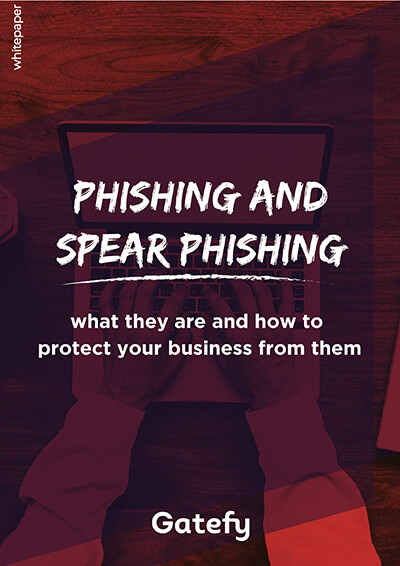How does email security work?

Email was created to facilitate communication between people. But it wasn’t designed to guarantee data security. Despite this, email has always been widely used to share sensitive data, especially in the case of companies. This is where email security gains importance.
It’s common for businesses to share confidential customer, employee, and project data via email. Other common examples are the payment of invoices that are received by email and even the sending of passwords and credentials, which isn’t recommended and much less secure.
Obviously, hackers know all of this and take advantage of the situation. Therefore, in order to protect yourself, you need to understand what email security is, the myths surrounding the subject and, above all, how email protection works. We’ll talk more about that in this article. Stay tuned.
Table of Contents

Email structure and similarity to letters
Before we delve deeper into the subject of email security, it’s important to understand how the process of sending emails works and the basic structure of an email. That way, it becomes easier to recognize points of vulnerability and to see how email is exploited by cybercriminals.
What are the elements of email?
To understand email structure, we really like the comparison between an email and a letter. It simplifies the understanding since both, a letter and an e-mail, have the following basic elements:
- Envelope, which contains information about the sender and the recipient.
- Header, with different information, such as date, sender’s address and name, recipient’s address and name, and subject.
- Body, which is the message itself followed by the sender’s signature.
Certainly, an email is much more complex than a letter. It has other elements and features that further arouse the criminals’ interest, such as the ability to attach files and send links.
For now, it’s important to know that hackers falsify and exploit each of these basic email elements to deceive, persuade and play with their victims.
How does email work?
It may not seem like it, but the process of sending emails has as many steps as sending letters. When you send an email, your message usually goes through a series of machines or servers until it’s delivered to the recipient.
It’s like a letter that depends on several people and travels through several post offices, located in different places, until it reaches the recipient.
A technology called SMTP (Simple Mail Transfer Protocol) is responsible for transporting email, while POP3 and IMAP technologies are in charge of delivering it. But make no mistake. This is a complex and sometimes lengthy process that’s often exploited by cybercriminals.
Email threats and techniques
Email threats exploit technological and human vulnerabilities. In practice, to deceive people, hackers use spoofing techniques to forge an email address, and also use social engineering to impersonate a brand.
In other words, criminals exploit technology and the human factor at the same time. In fact, the human factor is known as the weakest link in the information security chain, due to the difficulty of control and unpredictability.
Next, we’ll introduce common email threats and techniques.
Spoofing
Social engineering
Social engineering is a threat that allows the hacker to deceive and persuade people. For example, before sending a malicious email to your company, the cybercriminal will seek to know what your company does, what other companies it relates to and who your employees are.
Impersonation
Impersonation is the hacker’s ability to assume someone else’s identity. Imagine that someone is impersonating a top executive at your company to send malicious emails to the finance department requesting an invoice payment.
Email compromise
Compromising email accounts is a kind of hijacking. Your company may have been infected with malware that then gave access to the CEO’s mailbox. In this case, the hacker could read and send emails as if he were the CEO. This type of scam is called BEC (Business Email Compromise).
Email server and domain hijacking
Your domain and email server can also be hijacked by hackers. After hacking your server with some type of malware, cybercriminals will have access to all the information that travels through your email network. In addition, they will be able to use your domain to scam employees, customers, and partners.
Now that you’ve learned a little more about the ways email is exploited, let’s talk about phishing to better understand email attacks in practice.
Steps of a phishing attack
Phishing is the cybercrime with the highest number of victims in the world, according to FBI data. The phishing scam happens when the hacker uses spoofing, social engineering, impersonation, and other mechanisms to steal data or gain access to machines and systems.
1. Victim identification
First, the hacker needs to identify his victim, who may be a person or a company. At this stage, the cybercriminal will gather as much information as possible about you and your business.
2. Scam creation
In this step, the cybercriminal will try to impersonate someone you and your company already know and work with, such as a service provider. To do this, he will create a malicious email that looks a lot like your partner’s legitimate email.
3. Human factor exploit
In the last step, the criminal seeks, through a series of emails, to create a bond of trust with the victim, who is an employee from your company. In the end, he will persuade the victim to take some action, such as sending money or sharing confidential data.
The big challenge with email security is that criminals are becoming smarter by the day. They’re always developing new ways of hacking. To stay safe, you need to understand how to protect yourself.
How email security works
The email security operation requires, necessarily, the adoption of email protection solutions and the investment in the company employees’ education. In other words, your business needs to use advanced security technology and your team needs to learn how to recognize threats, mitigating risks.
Let’s talk now about 2 important and essential email security solutions.
Secure Email Gateway (SEG)
Secure Email Gateway (SEG) is a cybersecurity solution that acts as a barrier to block email threats. That is, when malicious emails are sent to your company, the SEG must detect them, preventing the threat from reaching your mailboxes.
To fulfill its role, SEG uses different mechanisms and technologies, such as spam filters, IP and address reputation lists, anomaly detection, antivirus tools, and, above all, artificial intelligence.
DMARC
DMARC (Domain-based Message Authentication Reporting & Conformance) is an email authentication protocol and mechanism. Basically, DMARC standardizes the way emails are scanned and checked.
That is, DMARC says whether an email is legitimate or not. This way, it prevents hackers from using your company’s domain to commit scams and fraud.
Final word
Emails are one of the easiest ways to communicate. However, they’re also used by cybercriminals as bait to steal data, spread malware, and hack companies. Therefore, it’s always necessary to be ahead of criminals.
The adoption of different email security solutions, such as those mentioned in this article, and awareness training about internet scams and threats will significantly help you to keep your company and data safe.




